First Nations Day
We humbly and gratefully acknowledge that our school is learning and gathering in the unceded homelands of the Muhheconeew (Moh-He-Con-Nuck, or Mohican) Nation, who are the indigenous people of this land. Despite the tremendous hardship of being forced from their ancestral home, today their community resides in Wisconsin and is known as the Stockbridge-Munsee Community.
We also honor the elders and land keepers, past and present, of First Nations in the four directions, including Schaghticoke and Lenape to the south, Nipmuc, Wampanoag and Massachuset to the east, Abenaki and Algonquin to the north, and Haudenosaunee to the west.
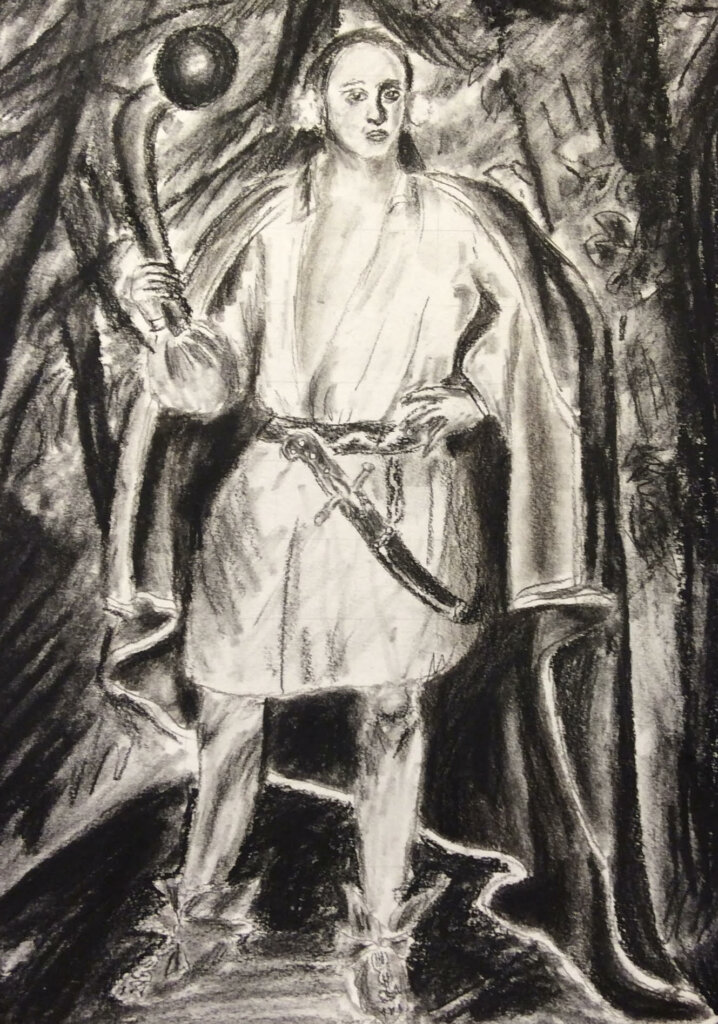
There are many celebrations and opportunities in the Berkshires this month to learn more about the First Nations of this sacred land.
Indigenous Peoples’ Day in Great Barrington
Drumming, traditional Native American songs, speeches, and a procession culminating in a ceremonial blessing of the Housatonic River will mark the local observance of Indigenous Peoples’ Day in Great Barrington on Monday, October 11. For details and to register, visit www.allianceforaviablefuture.org
First Nations Day at BWS
We’ll light the fires for First Nations Day, Tuesday, October 12, when Abenaki children’s book author, editor and storyteller Joseph Bruchac visits our school to share Northeastern indigenous nations’ stories, songs and drumming. You can find the extensive list of Dr. Bruchac’s books and stories here, and copies of many of them in the Mason and Ramsdell libraries, as well as at Bookloft and other local bookstores.
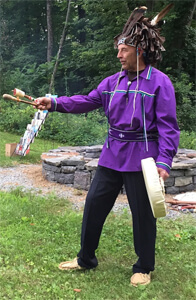
“We once called this land home, and while forced removal may have physically moved us, our hearts remain.”
-from the Berkshire Museum Exhibit Muh-he-con-ne-ok: People of the waters that are never still
Berkshire Museum
Muh-he-con-ne-ok: The People of the Waters That Are Never Still showcases the story of the Stockbridge-Munsee Communities past, present, and future.
Stockbridge Mission House and Walking Tour
Stockbridge Mission House now hosts a Stockbridge-Munsee Community-curated Mohican Exhibit.
And stroll through Mohican History with this Walking Tour of Main Street, Stockbridge, MA.
Stockbridge-Munsee Archeological Dig
The Mohican Tribal Historic Preservation Office conducted archaeological digs at “Indiantown”—now known as Stockbridge—this summer, to try and locate the 1739 meetinghouse site and the site of the ox roast that George Washington ordered there in honor of Mohican soldiers, in gratitude for their support, at the end of the Revolutionary War.
Sheffield Historical Society – “The Mohican Journey: Homelands, History, and Hope”
The Stockbridge-Munsee Band of Mohicans has worked for decades in research, preservation, education, and governance to promote equality and programs that strengthen their culture and community heritage. Making connections to their ancestral homelands continues to be of sacred value. This exhibit combines a variety of art forms, artifacts, audio and video elements, including content from Dorothy David’s “A Brief History of the Mohican Nation” as well as many personal narratives. Outdoor exhibit on view through Oct 11, weekends 11a-4p and Indigenous Peoples Day, Monday, Oct 11.
First Nations Books
Elder-approved books from the Stockbridge-Munsee Arvid E. Miller Library:
- The Mohicans of Stockbridge by Patrick Frasier
- The Mohican World: 1680-1750 by Shirley W. Dunn
- Stockbridge Past and Present by Electa Jones (contains an oral history of the Mohicans from the mid-1700s)
- Medicine Generations by Misty Cook (medicine plants of the homelands, aka the Berkshires)
- The Arvid E. Miller Library also has great stickers of the Stockbridge-Munsee logo, “Many Trails,” symbolizing endurance, strength and hope.
Forge Foundation
The Forge Foundation, located in the Mohican homeland near Hudson, NY, has launched an indigenous fellowship program to support the work of indigenous artists and activists.
Papscanee Island in the Muhheakantuck (Hudson) River
Read the amazing “land-back” account of how this island in the Hudson River – with a preserve that remains untouched since 1609 – has been returned to its original owners, the Mohican Nation, and you can visit it.
The aim [of this year’s Indigenous Peoples’ Day events in Great Barrington] is to “acknowledge and heal the wounds of our past, honor the Native American ethic of respect and care for the natural world, and integrate indigenous values into our response to climate change.”
– Alliance for a Viable Future
Lear More from the mohican.com website
STOCKBRIDGE-MUNSEE HISTORY VIRTUAL TALKS
-We are Mohican Nation Presentation for Stockbridge Munsee Day
-PBS: Stockbridge-Munsee Mohican History
-Footsteps of our Ancestors – Virtual Walking Tour of Stockbridge
-Finding A Place Again: Honoring the Mohican Story of Stockbridge with Bonney Hartley
-CTSB: 2018 Mohican History seminar & tribal elder Judy Putnam Hartley talk
-History Presentation for NY Fish and Wildlife service in 2015
-Williamstown – Living on Mohican Homelands
“Long Journey Home” Story Map on Stockbridge-Munsee effort to reclaim Papscanee Island
-Homelands History Series from the Arvid E. Miller Memorial Library Museum
OTHER RELATED TALKS
-Decolonizing Language: In conversation with Heather Bruegl and Dr. Anne Leilehua Lanzilotti
-Perspectives in Archeological Collaboration
-The Power of Native Women with Heather Bruegl
Indigenous Histories:
-Roxanne Dunbar-Ortiz: An Indigenous Peoples’ History of the United States
-Jean Maria O’Brien: Firsting and Lasting: Writing Indians out of Existence in New England
-David Treuer: The Heartbeat of Wounded Knee
2021 COVID Plan
COVID-19 Protocols for School Reopening
The Berkshire Waldorf School is pleased to share our Health and Safety Plan for the 2021-22 school year. The health and safety of our community is our top priority. We have worked diligently with the consultation of our Medical Advisory Panel (MAP) to put this plan together.
Click the button below to review our reopening plan for Fall.
BWS continues to closely monitor the impact of COVID-19. Thankfully, all the work we did last year to stay healthy and safe as a community is our best preparation for reopening school this year. We have a structure in place to implement policies that are deeply informed by experience.
The BWS Medical Advisory Panel (MAP) will continue as our ongoing advisors. Their expertise allows us to remain responsive to changing conditions. MAP is a collaborative trio of local family physicians with broad backgrounds in public health, first-line COVID response and Anthroposophic medicine, who are also current and alumni parents at our school.
Our school community met virtually for a Back to School Health & Safety Town Hall on Sunday, August 29. You can learn more about our school reopening plan by clicking on the button below.
We are looking forward to welcoming your children on the first days of school, Wednesday September 8 for the grades and Monday September 13 for early childhood classes!
May Day at BWS
Remember, Lords and Ladies, it is the first of May
In our 50th anniversary year, BWS continues a longstanding tradition of “welcoming in the summer” with the celebration of May Day. One of our most colorful festivals, Berkshire Waldorf School celebrates this outdoor event to shake off the last vestiges of winter and welcome summer with singing, dancing, music, flower crowns and an authentic Maypole.
For the first time in 40 years, last May we weren’t able to gather as a community. (There was fiddling, plenty of flowers and a food drive instead.) Our former Maypole became the tent pole for second Grade’s outdoor classroom, Maypole Cottage, during the pandemic. So this year’s celebration inaugurated our new 25-foot Maypole planted on the “village green,” in the center of campus, between the Betty Szold Krainis Early Childhood Building and the grade school building.
We were up long before the day
The ancient spring festival of May Day is brought to life at school with sprightly dancing and singing accompanied by musicians playing accordian, fiddles, flutes and guitar. Generally, the whole Berkshire community is warmly invited to bring blankets and picnic on the green; in fact, a local magazine declared BWS the “Best May Day in the Berkshires.” In prior years, country dancing included elementary students; performances by local Morris and Garland dancing teams; a dance for alumni, who came back to the school from all over the world; a faculty dance; and a dance for the whole community, followed by three rousing cheers of “Hip-hip-hooray” and May crowns tossed in the air.
To welcome in the Summer, to welcome in the May
May Day festivities started at BWS in 1981, when one of our teachers, Christopher Sblendorio, who had participated in May Day during his Waldorf teacher training at Emerson College in England, began doing country dances with his students. He realized that May Day made a perfect seasonal celebration in New England, too. After all, contra dancing has long been an important part of the social fabric here.
At BWS, fourth through eighth graders literally move through the end of winter by learning country dances during the weeks of waiting for spring, using ribbons, bells, kerchiefs and wooden sticks. Similar celebrations take place all over the world, with different music, different dances, but the same purpose; in nearby Columbia County, New York, members of the Mohawk Nation are also dancing with bandanas to wake the earth!
There’s a lot of strength in having something to look forward to. “When I’m in 5th grade, I will dance the Maypole, too!”
Living close to the land and seasons in the Berkshires, honoring May Day is one of the ways we mark transitions in the seasons of life. And celebrating together the transition from a New England winter (or a global pandemic) connects us to the Earth, our human past and present–our community. We delight in Second Grade’s spontaneous singing at the bus stop, and the early childhood children full of joy in their May crowns.
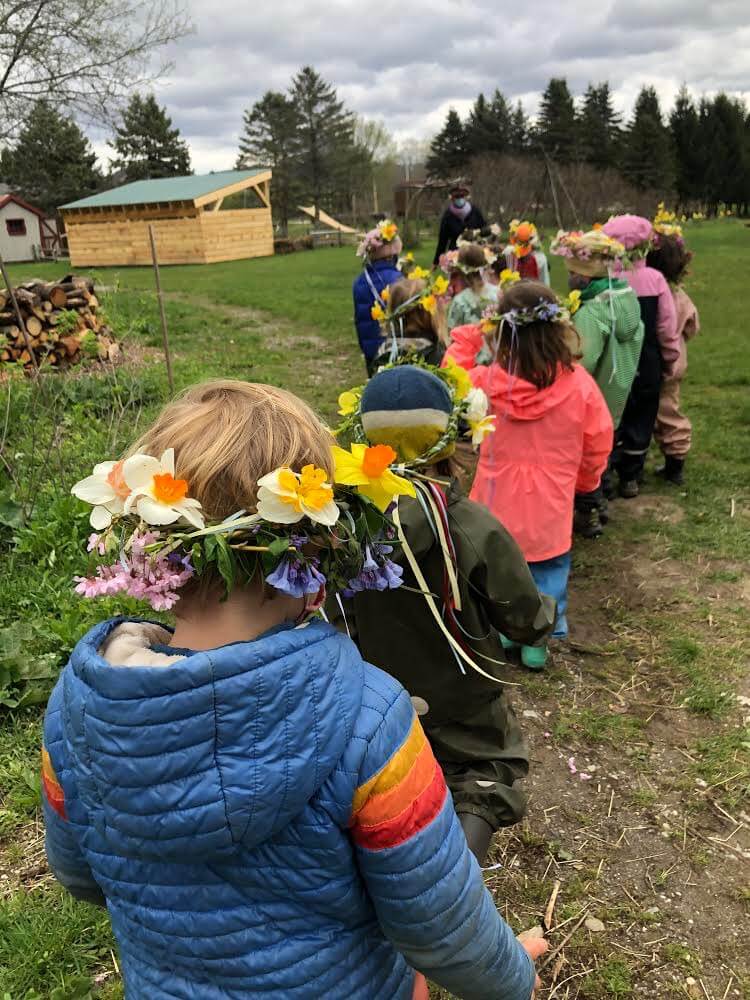
For summer is a-coming and the winter’s gone away
In our Berkshire Waldorf tradition, fourth grade performs a long and complex dance called “Goddesses,” an English country dance. Adults would have a hard time doing this one, because it’s so long, but fourth graders are overjoyed. It has a beautiful figure-eight chorus which is so harmonious, they can do it and do it, and they don’t get tired. Fourth graders are so light, and they skip easily.
In sixth grade, students do their first Morris dance, with bells and sticks. This tradition is called “bean-setting,” of putting beans in the ground, with wooden sticks rhythmically rapped together or on the Earth. It has the same weaving figure as in Goddesses, and in the Maypole dance, but a different kind of stepping. It’s not the light and easy skip fourth graders do, but step-hop, step-hop. Sixth graders are moving through adolescence; they’re starting to feel the weight of gravity, and they have to overcome it to spring into the air. The rhythm of the dance moves them to make that effort.
Through seventh and eighth grades, students learn more complex dances, using short or long wooden sticks, bells or handkerchiefs — and laughter is such an amazing part of it all.
Fifth graders perform dances that weave bright ribbons around the Maypole. Because they are in that “balanced” place in our school, between being younger and being older, fifth graders are perfectly capable of a more complex figure, based on the “weaving” they learned in Goddesses the year before, yet they are still young enough to enter into the dance. They’re also just the right height to be able to dip under the ribbons at the very end. And then that look on their faces of “We did it!” Weaving together all those different strands is a metaphor for life. The teachers say, “We don’t tell them; they learn by doing it.”
Energy, joy, flowers and dancing – just what you want after a snowy winter in the Berkshires.
Since the BWS community wasn’t able to gather (even outside) on May Day last spring, both fifth and sixth graders shared the Maypole dance, weaving their ribbons around the pole in quite the seaworthy wind! The bright ribbons will remain woven around the pole until they are “undanced” on the last day of school, as we enter full summer.
Happy May Day!
Diversity & Inclusion in Kindergarten
Rainbow Room Kindergarten is celebrating Khmer New Year this week, singing a Khmer song and hearing a Khmer fairy tale in circle time. Did you know the third-largest Cambodian community in the world, after Cambodia and California, is in Massachusetts?
A New Friend
Teacher Charlotte Hoppe writes: ”A ‘new student’ named Kim Huoy joined our class this week. We are treating her as a peer because it’s important that the children’s relationship to this Persona Doll feel real and personal. By encouraging their imaginations to grow in this way, we can work with the values of empathy, sympathy and feelings as a shared experience.
“This work is based on the concept of ‘windows and mirrors’ when it comes to diversity, equity, and inclusion education. We want our children to have the chance to see themselves mirrored, but we also provide opportunities to see into someone else’s life, and what it’s like to live or look differently than they do. This helps us celebrate both the ways we are the same and the ways we are different.
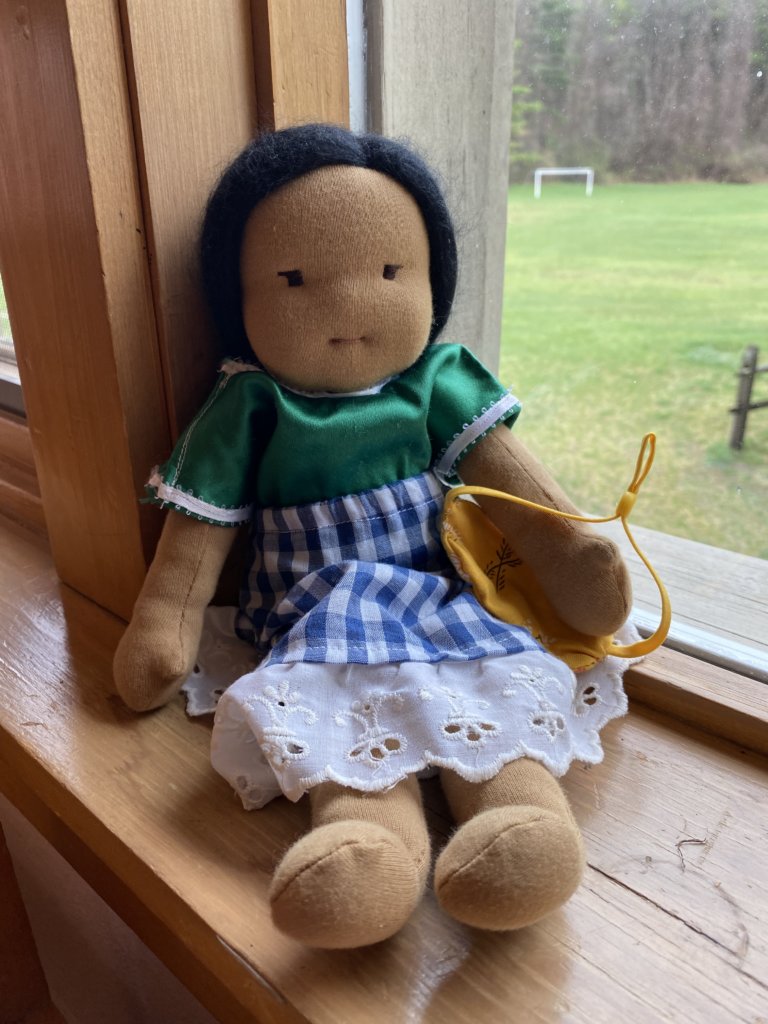
“I introduced Kim Huoy (a doll that I made),” Ms. Charlotte continues, “And shared parts of her background story–not all of it, just little parts as they come up in conversation naturally. Here is the story as I created it for Kim Huoy:
- She is Khmer-American and just moved to Massachusetts with her mother and father.
- They moved here because of the virus and her dad’s new job. Her mom is Cambodian (Khmer) and her dad is American, from Massachusetts originally. They met when her mom was going to college here, then moved back to Cambodia to get married and work for awhile, so that her new husband could meet her family. Then they had Kim Huoy, who is now 5 years old.
- In Cambodia, Kim Huoy lived with both her parents and grandparents; since they have moved, she is missing her grandma and grandpa. She loves to jump rope and play hide and seek. But she’s a little nervous about going to a new school, and doesn’t love the cold weather because she isn’t used to it yet.
- She loves fruit, especially watermelon, and her grandma’s chive cakes. She even likes spicy food, but she doesn’t know if she will like our snacks at school.
- At her old school, Kim Huoy had to wear a uniform every day, so she is really happy to wear her own clothes to school now. In Cambodia, her dad used to drive a moto to take her to school, and she had to wear a helmet. Now they have a car, and she likes to look out the window.
- Wearing a mask is easy for Kim Huoy. People do it all the time where she used to live, even before the virus. It helped her stay healthy, and she likes masks with cool patterns and colors.
- She has black hair and brown skin, and can speak a little bit of Khmer, but mostly she speaks English. Her family is Buddhist. She loves visiting Angkor Wat, and being blessed by the monks.
“These details help build Kim Huoy’s personality,” Ms. Charlotte continues, “And help to inform how she might answer the children’s questions. Because I lived and taught in Cambodia, it’s easy for me to bring her story with true depth of understanding, authenticity and enthusiasm. Personal experience also helps to avoid stereotypes and assumptions.”
Story Circle with Kim Huoy
“Our first circle with Kim Huoy was a huge success,” Ms. Charlotte says. “The children were kind, welcoming, brave and had many great ideas. I was so proud of them! We will continue this work in circle time, and if we have a pattern of behavioral problems, or a social incident that causes someone to feel left out, teased, or embarrassed, I can bring out Kim Huoy to help the children work through their own emotions and find solutions as a team.”
Khmer New Year in Massachusetts
Rainbow Room kindergartners will celebrate Khmer New Year in their circle starting on April 15th, with a special fruit feast. Families are also invited to connect to the local Cambodian community of Lowell, Mass during this festive time of year. The celebration will include singing, dance and poetry.
Sour Sdey Chnam Thmey (Happy New Year)!“
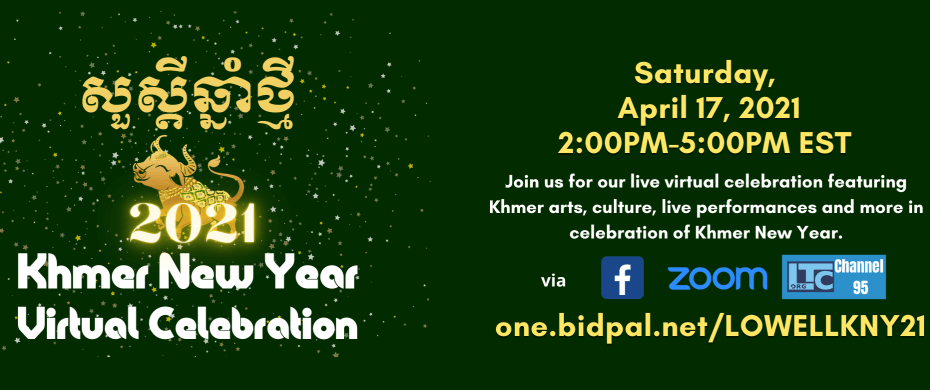
To learn more, Ms. Charlotte recommends these books for children:
Colors of Cambodia highlights one thing from Cambodia for each color of the rainbow. It’s is written in English and Khmer. Many children noticed how the Khmer symbols look like Hebrew symbols and they all loved the painting of the Khmer dancers and the monks.
The Cambodian Dancer – Sophany’s Gift of Hope is about a young girl who was a dancer before the Khmer Rouge (“bad people”) came to Cambodia. This child-appropriate story tells how Sophany came to live in the United States, and how her gift of dance made her feel close to her culture, so she opened a school of dance for the Cambodian children in California. The story is told in a beautiful and artistic way, but highlights that there were people who didn’t know how to share, made lots of bossy rules that hurt peoples’ feelings, and forgot to act with love and kindness. Ms. Charlotte adds: “This story provides a great opportunity for talking about empathy. It helps to address some of the bigger problems of race and racial injustice in our culture today that many children in our class are aware of and trying to understand.”
Celebrating Black History
As we honor Black History Month in February, BWS is thrilled to be taking part in a webinar conversation with New York Times bestselling author Ibram X. Kendi (How to be an Antiracist). This program is sponsored by the Association of Independent Schools in the Northeast (AISNE), one of our school accrediting bodies. 95 independent schools across the Northeastern U.S. will join for a collective listening of parents, teachers, staff and trustees. Dr. Kendi’s talk, “Go Beyond an Awareness of Racism: Contribute to the Formation of a Truly Just and Equitable Society,” will take place online starting 5pm on Wednesday, March 3. Adult members of the BWS community will receive an email to register for this evening. After Dr. Kendi’s talk, all participants are invited to participate in community conversations and affinity spaces.
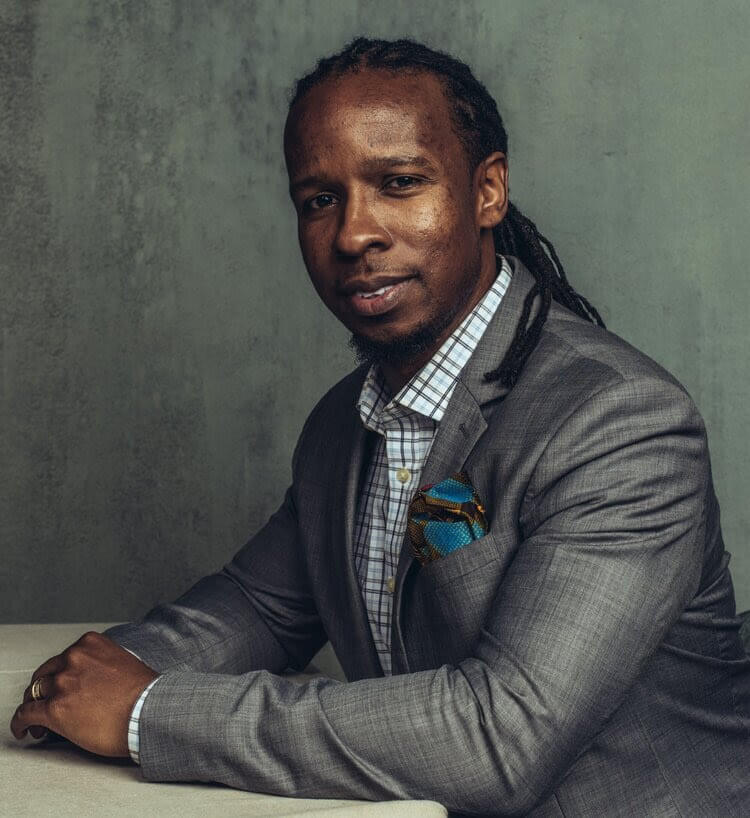
Unify for Change
During February, Berkshire Waldorf School teachers usually join 500 early childhood teachers at Green Meadow Waldorf School in Spring Valley, New York for the Waldorf Early Childhood Association of North America (WECAN) Conference. Pumpkin Patch kindergarten teacher Christianna Riley writes, “This year, due to COVID, we combined East and West Coast WECAN Conferences virtually. There were over 800 participants, and the theme for the weekend was Black Lives Matter.
“I’m thrilled that my colleagues and the Waldorf Early Childhood movement have taken up anti-racist, anti-bias and social justice education as important and necessary. I came back to our Berkshire Waldorf School community inspired and humbled, with many ideas for how we can work together as a community for equity and justice. “
Learn Black History
Rose Room Nursery teacher Beth Oakley, who also attended the conference, recommends a resource from academic, writer and activist Rachel Cargle. Cargle’s project Discover Our Glory is a curated guide to educating oneself about Black History. It highlights the fact that Black History is inseparable from American History.
This worksheet includes prompts that you can research on your own to learn more about the rich history of African American people.
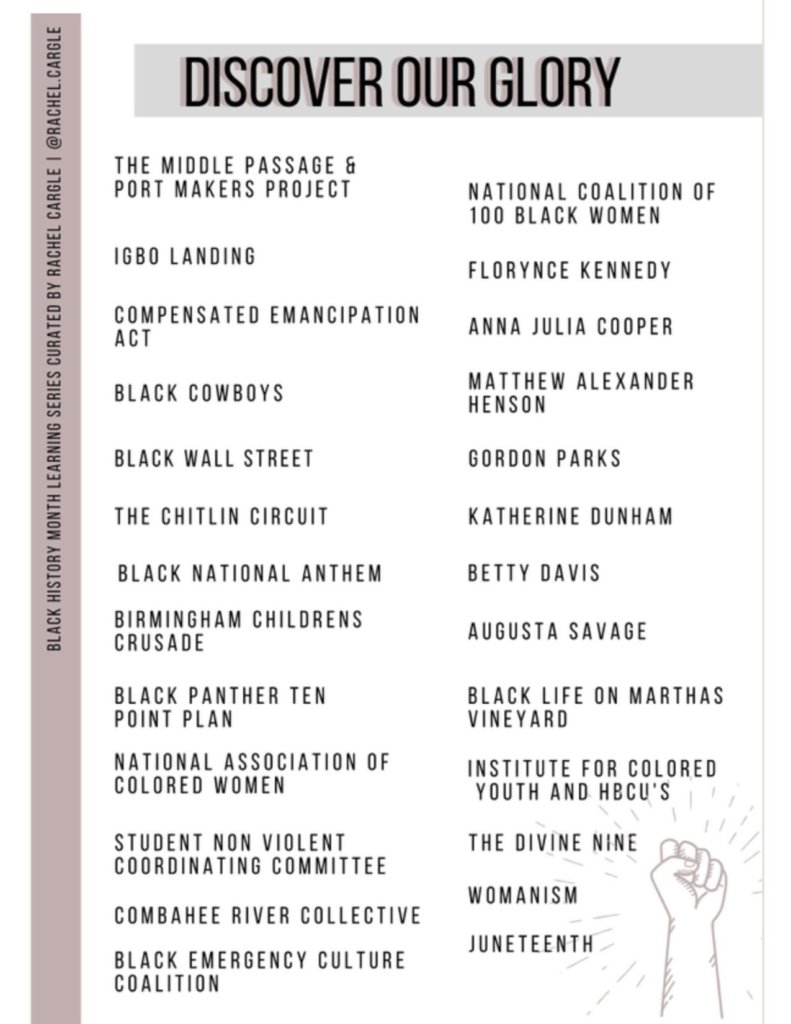
“Each item on the list is a part of Black history to research during February,” Ms. Oakley writes, “I’m taking it day by day, and I encourage our whole community to join in. Even if I know about a topic, I still make a point to read up and reflect on it. This is a simple and powerful way to educate oneself.”
Creating a Just Society
Mrs. Riley writes that she is continuing the journey she embarked on in January, with the AntiRacist 30 Day Challenge. “I have been exploring the platform,” she continues, “And found insightful and powerful information. I highly recommend both these endeavors.”
“Remember,” Ms. Oakley adds, “If we actively and genuinely pursue antiracism and social justice in our own lives and within ourselves, our young children will pick up on that gesture and learn–as they grow up–to do the same.”
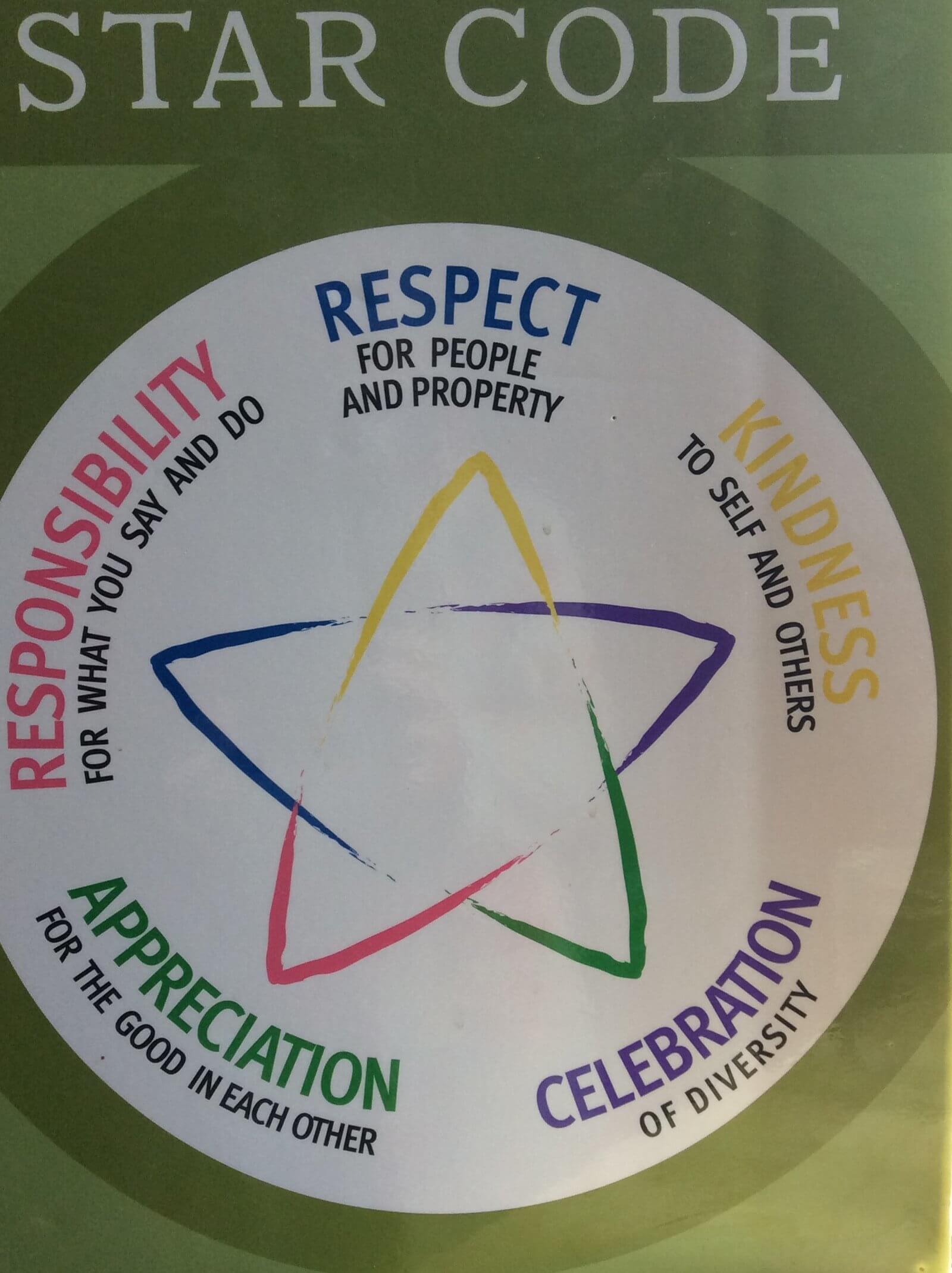
Happy New Year! Celebrating our 50th Anniversary in 2021
In the midst of so much social and political upheaval, and an intensifying pandemic, we have one smile for today. It’s the 50th Anniversary of Berkshire Waldorf School – our birthday!
Rudolf Steiner founded Waldorf education in Stuttgart, Germany in 1919. At a low point of hope for the human race, after the “war to end all wars” and a global influenza epidemic, Steiner’s plan for education provided healthy growing and learning for children as a system of social renewal. Now Steiner/Waldorf education is an international initiative. Berkshire Waldorf School is one of more than 1,000 schools worldwide which were literally made for these times.
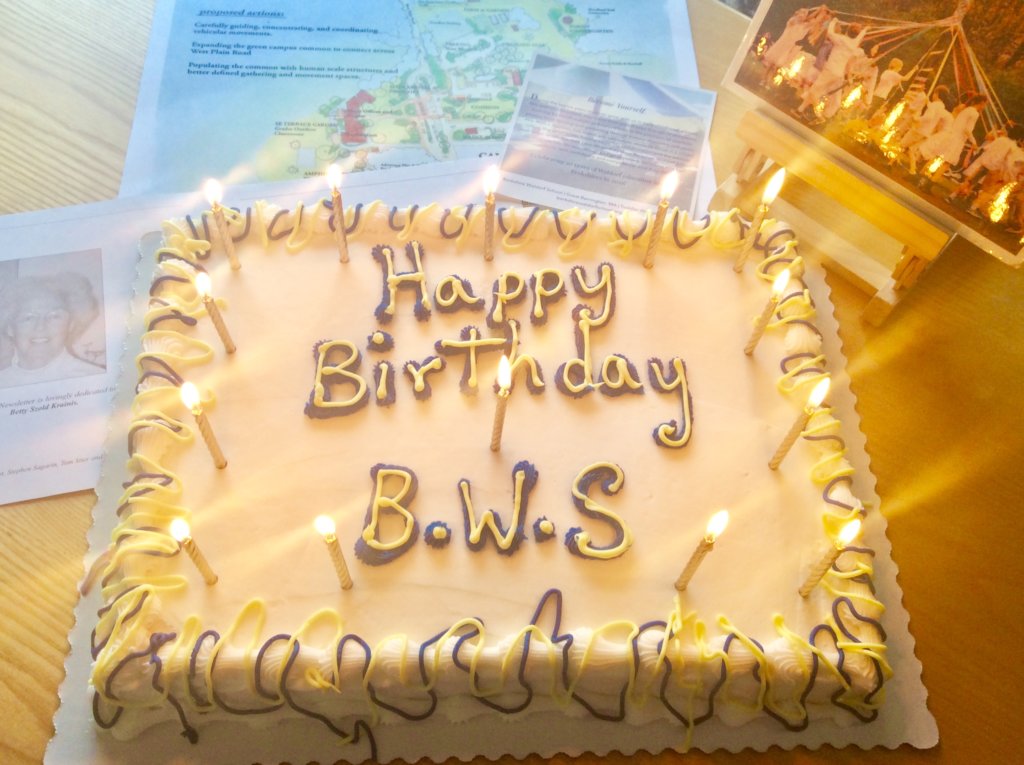
Kindergarten teacher Betty Szold Krainis founded BWS (originally named the Pumpkin Hollow School) on January 13, 1971. The original schoolhouse, a handmade Berkshire timber framer from the early 19th century, is the same barn that now houses the BWS library, the heart of our school. Current BWS parents who were Mrs. Krainis’s students in that cozy space still get a shiver of happiness when they walk through the door!
Today we’re having a surprise party to celebrate the brave and creative teachers who are carrying on this legacy in the face of a global pandemic. And you’re invited to the party! At our virtual tours during the month of January, you’ll get a peek at gardens and grounds, including our new outdoor classrooms. You’ll learn more about our programs for toddlers through 8th grade, and how BWS has provided in-person, on campus learning for all of them this year. We’ll save plenty of time for your questions.
· Next meeting time Jan 13, 2021 7:30 PM Eastern Time (US and Canada)
· Register in advance here:
https://us02web.zoom.us/meeting/register/tZElcOiurDwjH9e-emzIVwcJNqKxb0hTGAnc
When you register, you’ll receive a confirmation email with a link to join the meeting.
BWS will host a few more virtual visits this month, before our February 1 application deadline for the 2021-22 school year. Check our Admissions page to register.
Once you attend Part 1: Virtual Visit, stay tuned and plan to attend Part 2: Getting Started, an interactive workshop for parents to learn more about joining a learning community that’s based on freedom, inclusivity, and mutual support. Both introductions are prerequisites to your family interview with your child’s prospective teacher. Interviews begin after Winter Break, February 22.
In the meantime, enjoy this look at our first big snow in December, and imagine a school where play is an important part of learning to be human.
See you soon!
The Season of Light
In the Berkshires, when the earth falls quiet under winter snows, we look forward to the sun’s return and lengthening days, and look inward to reflect on the passing year.
Do you remember the first weeks of school, when we welcomed Autumn as the Season of Courage? Stories, songs and plays about courage strengthened us all the way through those first brave months we were back together. Now we carry that strength into the Season of Light, ushered in with the lantern walk for early childhood and first and second grade students.
The Longest Night
BWS celebrates the Season of Light around Winter Solstice, the shortest day and longest night of the year. Joining many cultures in a spirit of joyful anticipation, we bring light and warmth into the darkness with candles, holiday lights and observance of the moon and stars. As a community, we take comfort in the light of family, food and traditions of giving.
Lighting the Darkness
BWS kindergartners participate in the Spiral of Light, which brings a mood of quiet reverence to the season. Each child walks a spiral path made of evergreen boughs strewn with minerals and crystals. As they reach the center, children light their “apple candle” at the central candle, and place it along the path home, to light the way for others.
Elementary and middle school students mark the Season of Light with age-appropriate festivals and rituals that come out of the content from each grade. These speak to children with soul-satisfying comfort and peace. Adjusting for social distancing, our celebrations will look a little different this year. Yet they are more important than ever. Practicing warmth and joy at a dark time centers us all in strength and hope.
Although safety restrictions prevent our annual celebration with BWS families, students will honor festivals of light in their classes. On December 18, the last day before break, grade school students will gather for a holiday assembly. (Students are able to socially distance in the natural amphitheater on the sledding hill.) We’ll share a video record with parents afterward, as a holiday greeting to enjoy and share.
A Sense of Wonder
Third grade knitting together around the fire, and a kindergartner’s delight at “glitter covering everything” in the recent snow, remind us how fortunate we are to be surrounded by nature. In a dark time, look up! The Season of Light offers more time to enjoy a sky full of stars. How delightful to learn with sixth grade that this year on December 21—coincidentally, the Winter Solstice—Jupiter and Saturn will align in a Great Conjunction. Together they will create a very bright “star” on the southwestern horizon just after sundown, a celestial event that hasn’t happened in 800 years!
Berkshire Waldorf School faculty and staff wish your family a beautiful holiday season, and memories that bring renewed warmth and light throughout the years.
Building Together
Along with all Massachusetts schools, Berkshire Waldorf School (BWS) closed for in-person classes March 13, 2020 due to COVID-19. This summer, trustees, teachers, parents and staff tapped their talents the way students tap maple trees here in the spring. After months of planning and building, classes reopened September 8, 2020, on campus in new outdoor classrooms.
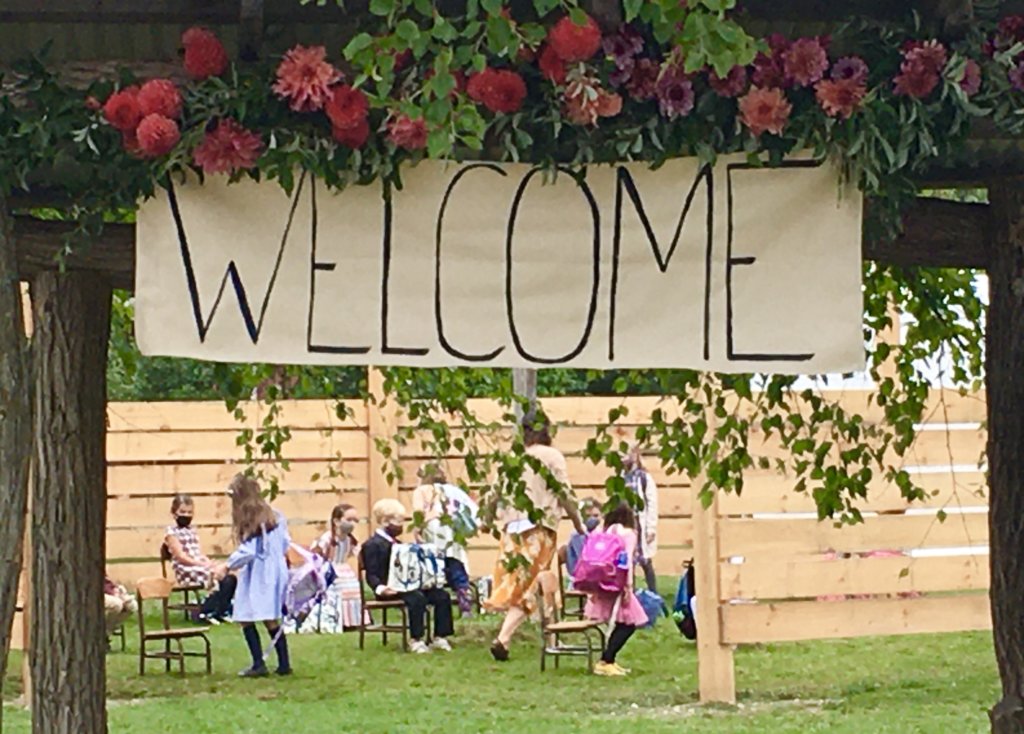
Powered by Community
The BWS Board of Trustees appointed Karen Fierst as the school’s Reopening Coordinator. Ms. Fierst’s career spans teaching and then serving as an administrator at prestigious New York City schools. Most recently, she was Head of the Lower School at the Green School in Bali, Indonesia (which operated under another daily threat—a live volcano).
“FIRST WE BUILT THE MINDSET TO DEAL WITH UNCERTAINTY. WE PRIORITIZED COMMUNITY, ADAPTABILITY AND SHARED RESPONSIBILITY, SO THAT WE ARE READY TO FACE WHATEVER COMES.”
Reflecting on the collaborative process of reopening, Ms. Fierst said, “We all took a deep breath, and focused on education for sustainability.
“First we built the mindset to deal with uncertainty. We prioritized community, adaptability and shared responsibility, so we are ready to face whatever comes.
“We created a flexible calendar that chunks the school year into seasons. That allows us to extend school days into summer, if need be.
“And we are very fortunate to partner with the BWS Medical Advisory Panel, a group of esteemed local doctors who are parents at the school. They give us the flexibility to make informed and autonomous decisions, based on metrics and state, CDC and local safety guidelines.
“Next, we rolled up our sleeves and built outdoor, open-air ‘cottages.’ Our reopening was truly thanks to teams of volunteers who dug post holes, constructed weatherproof desks out of tree stumps, and hung shade sails over our forest ‘base camps.’
“Berkshire Waldorf School showed the true spirit of community—building something together. Finally, we reopened slowly and gently. The finishing touches of our reopening plan were designed based on real experience. Our reward? Being able to serve children and their families with on-campus, in-person learning.”
“BERKSHIRE WALDORF SCHOOL SHOWED THE TRUE SPIRIT OF COMMUNITY—BUILDING SOMETHING TOGETHER.”
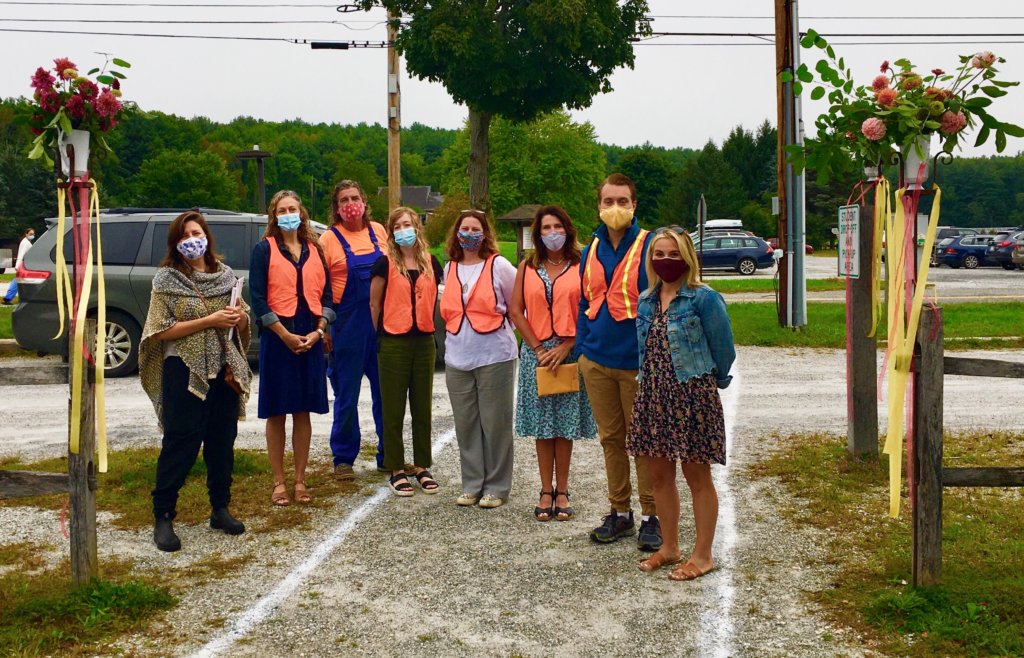
A sense of belonging
Fortunately, the State of Massachusetts continues to prioritize in-person learning. Building on our community’s capacity for flexible and creative adaptation, BWS is now celebrating the Season of Light, as we enter deep winter. How can we help you close the “six-foot gap”?
The magic of a handmade holiday is a BWS tradition – this year you’ll find our 48th Holiday Handcraft Auction online December 7-18.
Peek into life at BWS with our upcoming virtual visits, plus family “Looking Ahead” events, all from the comfort of home. No need to book a sitter!
We are accepting Fall 2021 applications for students 18 months through 8th grade right here.
We hope you’ll join us.
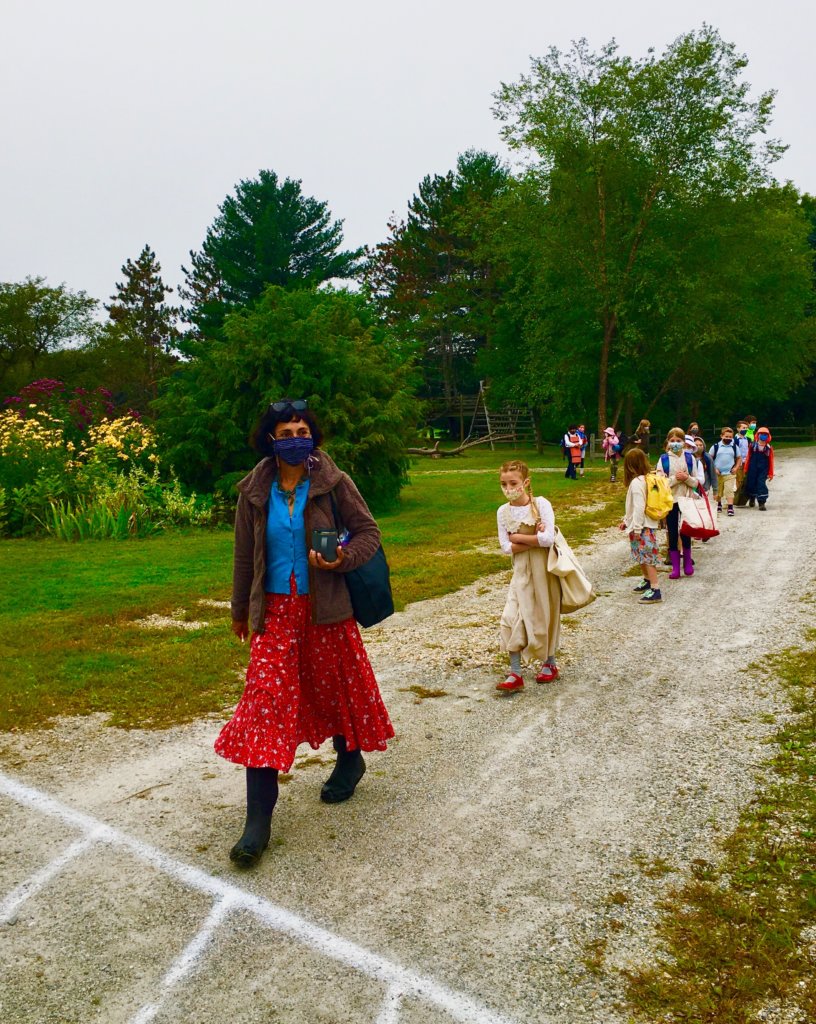
What do we celebrate when we celebrate Thanksgiving?
We are all so ready for some celebration. We have almost made it through the fall term, miss our friends and family, and long for a sense of normalcy, to help orient ourselves in this disorienting time.
How do we celebrate, when not everyone is celebrating? This year, we are truly thankful for another journey around the sun. To celebrate in the midst of so much loss, when the earth is calling for a time of introspection and healing, means holding our families close. From closeness comes comfort and calm.
Our community’s outpouring of generosity in this time of need, by actions such as giving food to the Peoples’ Pantry, is a start at widening the circle of love and support to our neighbors. Part of what we celebrate with sharing is that the Indians in what is now Plymouth, MA gave “essential survival knowledge to the Pilgrims and taught them how to cultivate the land, including teaching them which crops grew well, how to avoid dangerous and poisonous plants, and how to extract sap from maple trees.”
Do we see the mercy and the generosity of people who did not see the “other” as an enemy, but as a human being? Do you know what became of Ousamequin, know as Massasoit or great sachem (leader), and Tisquantum (Squanto), and how this generosity was repaid?
The “First Thanksgiving”
In a speech planned for the 350th anniversary of the Pilgrims’ landing at Plymouth rock in 1970, Wampanoag Wamsutta James wrote these remarks:
It is with mixed emotion that I stand here to share my thoughts. This is a time of celebration for you—celebrating an anniversary of a beginning for the white man in America. A time of looking back, of reflection. It is with a heavy heart that I look back upon what happened to my People.
Even before the Pilgrims landed it was common practice for explorers to capture Indians, take them to Europe and sell them as slaves for 220 shillings apiece. The Pilgrims had hardly explored the shores of Cape Cod for four days before they had robbed the graves of my ancestors and stolen their corn and beans. Mourt’s Relation describes a searching party of sixteen men. Mourt goes on to say that this party took as much of the Indians’ winter provisions as they were able to carry.
Massasoit, the great Sachem of the Wampanoag, knew these facts, yet he and his People welcomed and befriended the settlers of the Plymouth Plantation. Perhaps he did this because his Tribe had been depleted by an epidemic. Or his knowledge of the harsh oncoming winter was the reason for his peaceful acceptance of these acts. This action by Massasoit was perhaps our biggest mistake. We, the Wampanoag, welcomed you, the white man, with open arms, little knowing that it was the beginning of the end; that before 50 years were to pass, the Wampanoag would no longer be a free people.
National Day of Mourning
Instead, James was not allowed to speak these words. Since the year his speech was suppressed, this day has marked a National Day of Mourning. Moonanum James and Mahtowin Munro explain:
Every year since 1970, United American Indians of New England have organized the National Day of Mourning observance in Plymouth at noon on Thanksgiving Day. Every year, hundreds of Native people and our supporters from all four directions join us. Every year, including this year, Native people from throughout the Americas will speak the truth about our history and about current issues and struggles we are involved in.
Why do hundreds of people stand out in the cold rather than sit home eating turkey and watching football? Do we have something against a harvest festival?
Of course not. But Thanksgiving in this country—and in particular in Plymouth—is much more than a harvest home festival. It is a celebration of the Pilgrim mythology.
According to this mythology, the pilgrims arrived, the Native people fed them and welcomed them, the Indians promptly faded into the background, and everyone lived happily ever after.
The truth is a sharp contrast to that mythology.
Telling the Story is Teaching the Story
In eighth grade American history, our students learn about Revolution—the French Revolution, American Revolution, French and Indian Wars, the so-called Beaver Wars, and the Industrial Revolution. To the victor go the spoils. The victors also control the story, which includes the stories in children’s books and textbooks.
So consider the story of the “First Thanksgiving” as just that, a story—the New York times recently called it a myth. American Indian Movement activist Russell Means called Thanksgiving “Thankstaking.” He also points out that there were many feasts in Plymouth when the Indians shared food with their starving neighbors, but that the first “official” Thanksgiving Governor William Bradford declared was in gratitude for the massacre of an Indian village. Even Parenting Magazine writes, “Thanksgiving signifies a whitewashing of history, and an attempt to deflect from the atrocious harm caused to indigenous groups by European settlers.”
True History of U.S. (Us)
On First Nations Day this year, Pumpkin Patch kindergarten teacher and member of the BWS Diversity, Equity and Inclusivity (DEI) Committee Christianna Riley visited the New England Peace Pagoda. She writes:
I had the great privilege of being invited to the New England Peace Pagoda’s 35th Inauguration Ceremony (socially distanced and responsible). I am including the link to a livestream that was taken. This is for parents only. The part I would like to share with you begins around 48 minutes into the livestream, a beautiful song and then a speech given by Sonia Little of the Mashpee Wampanoag Nation, located in what we now call Cape Cod, Mass. Sonia is the granddaughter of the late Supreme Medicine Man of the Wampanoag People, Slow Turtle. She gives a heartbreaking, clear and concise truth about the history of the USA and the First Nations of Turtle Island. I believe that hearing Sonia speak is a deed of great courage. This is the history of the USA and of Humanity. We are all related and connected. This is an offering to raise our awareness and to know history so that we can make a better future for our children and the Earth.
We are Grateful
So you might be wondering, What do I tell my children about Thanksgiving?
Start with learning about Thanksgiving and ways to practice gratitude from Indian writers and storytellers. Learn about food sovereignty, and consider adding diversity to your celebration with a dish that includes rich indigenous flavors like corn, beans and squash. Some resources are listed below.
While it’s important that parents know and listen to the truth of history, third grade teacher Victoria Cartier points out that you will want to tune what you say to your children’s age and development. For example, with early childhood students, the focus is on making the food and saying a blessing for all the good gifts of the earth. “And I would add gratitude to nature,” Mrs. Riley suggests. “Taking walks in nature, being in wonder and admiring its beauty. Young children are so good at finding ordinary rocks or sticks as beautiful and special treasures. We can learn from them.” With third graders, Ms. Cartier says she would emphasize generosity, working together for the good of all, and gratitude. In eighth grade, children are ready for and seek the truth, and that’s a time to share more details. In high school, students will want to act for justice.
Making Space for Listening
Some believe that the world will not heal until the earth can heal, and that in order to restore health, nations who have been “removed” must return to their sacred homelands. The water protectors, as you know, stood at Standing Rock for all of us—people and animals alike. The Lenape, who traded Manhattan for trinkets because they couldn’t conceive of selling the earth, are beginning to return to New York, working to teach what they know to save the earth for all. Once again, we are hungry in so many ways, and winter is approaching. Can we listen, and return generosity and mercy with respect and dignity? Can we change the end of the story this time, so all life can flourish? Let our celebration be a commitment to hearing all voices, leaving a space for silence so we can hear what the world is asking of us.
Some Resources:
We Are Grateful: Otsaliheliga by Traci Sorell
Squanto’s Journey: The Story of the First Thanksgiving by Joseph Bruchac
1621: A New Look at Thanksgiving by Catherine O’Neill Grace
The Thanksgiving Myth Gets a Deeper Look This Year
How to Celebrate Native Americans This Thanksgiving
Listen to Indigenous American Podcasts
Cook 10 Essential Indigenous Foods with The Sioux Chef
Faces of the Lenape Tribe, the Original Inhabitants of Manhattan
Massasoit’s Strategic Diplomacy Kept Peace With the Pilgrims for Decades
Greetings, all my relatives
In honor of First Nations Day, and to begin the work of truth and reconciliation, we want to acknowledge that our school is on the traditional territory of the Muhhekunneuw (Mohican) Nation, the people of the flowing waters, whose territory originally ranged west beyond the Muhheakantuck (Hudson) River, the “river of tides,” from which they take their name.
In their own language, the Mohican referred to themselves as the “Muhhekunneuw” (ma-hee-kan-ok), “people of the great river.” This name was difficult for the Dutch to pronounce, so they settled on “Manhigan,” the Mohican word for wolf and the name of one their most important clans. Later, the English altered this to the now-familiar Mahican or Mohican.

Words can divide or multiply, add or subtract. So it’s important to note that Henry Hudson didn’t “discover” the Hudson River; it was the site of a thriving civilization, whose people had adapted to live as part of the land, waters and wildlife of the River Valley skillfully and with great success for 10,000 years. The Muhhekunneuw had 40 important council fires, up along what is now the Hudson Valley as far north as Lake Champlain and Lake George; their winter home was on the banks of the Housatonic River. These were the people who met the Half Moon, as it followed the tidal river on its second journey to find a shorter route to China, greeted Henry Hudson and his sailors, and taught them all they knew about living in this plentiful land.

Donald Shriver, president emeritus of the Union Theological Seminary in New York, and Stephen Kent Comer, last lineal survivor of the Mohican Nation in the vicinity of Columbia County, added a historical marker alongside the already-existing History of Columbia County marker at the northernmost overlook of the Taconic Parkway. The original marker tells of Hudson’s arrival in 1609, with no mention of the Mohicans. Comer noted, “When I came to this area thirty years ago, I was amazed to find virtually nothing about my people in their native land. It was as though we were a ghost people.”
One of the most important ways we can acknowledge the elders and ancestors who cared for this beautiful land is to acknowledge their presence by speaking of them in the present tense. The remnants of the mighty Mohican nation are alive and well and living in Wisconsin. Their demise (in The Last of the Mohicans) has been greatly exaggerated.
We can learn more about how the Mohican Nation came to be known as “Stockbridge Indians”and why they live in Wisconsin today.
What sacred land do we stand on? We can honor Indian nations by respectfully acknowledging ancestral lands.
We can honor ancestors and elders by caring for this land with the same reverence, tenderness and gratitude. For example, we thank the plant before we take a leaf for food or medicine.
We can honor tribal rights by referring to indigenous people in this country as American Indians. Since all the treaties the U.S. made were with “American Indians,” using this term upholds Indian rights and dignity as sovereign nations.
We can read books with our children by and about American Indians. We can savor the work of the Poet Laureate of the United States, Joy Harjo, the first American Indian poet appointed to that role.
We can remember the words of an Indian grandmother to her grandchild: “I am nothing without you,” and acknowledge on a daily basis that our survival depends on respecting our connectedness rather than living in our differences, so the choices we make will be in the best interest of many people.










